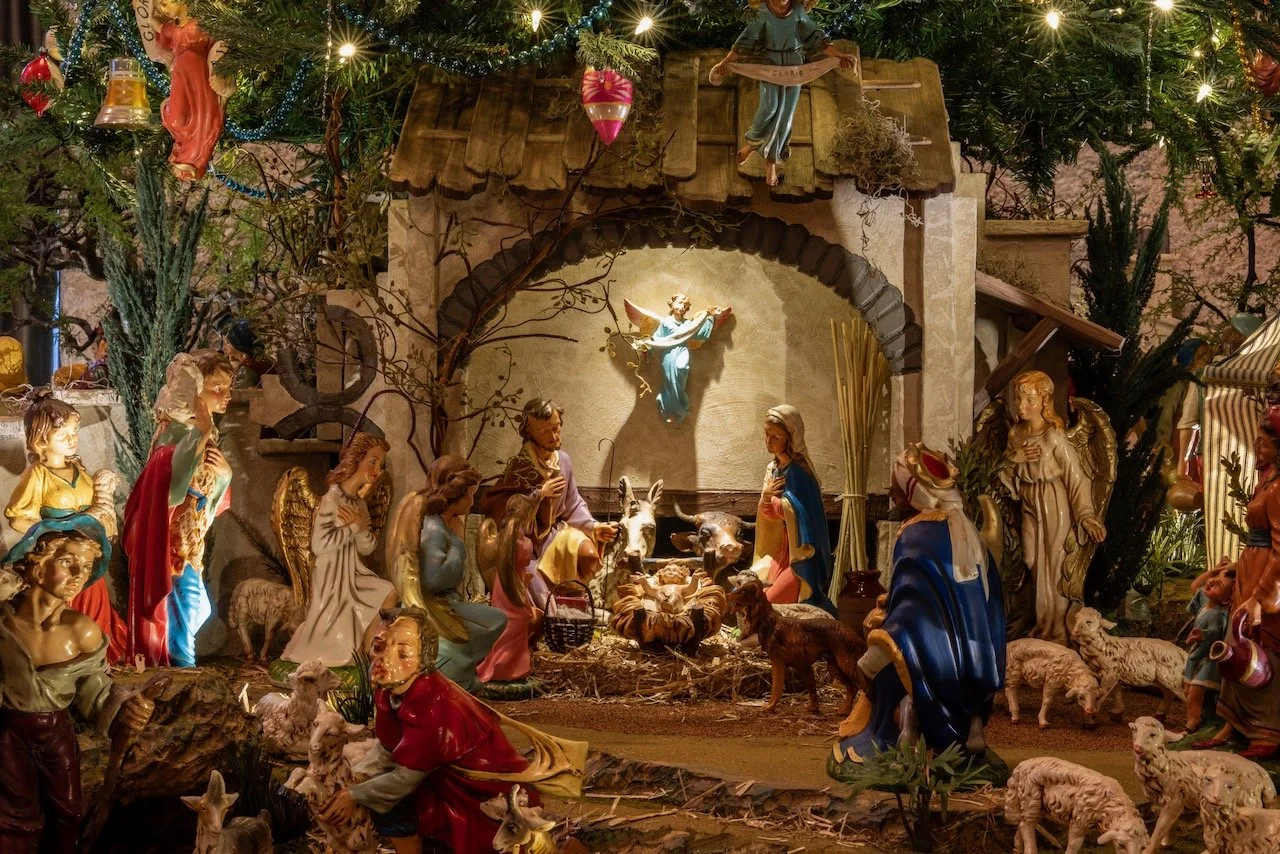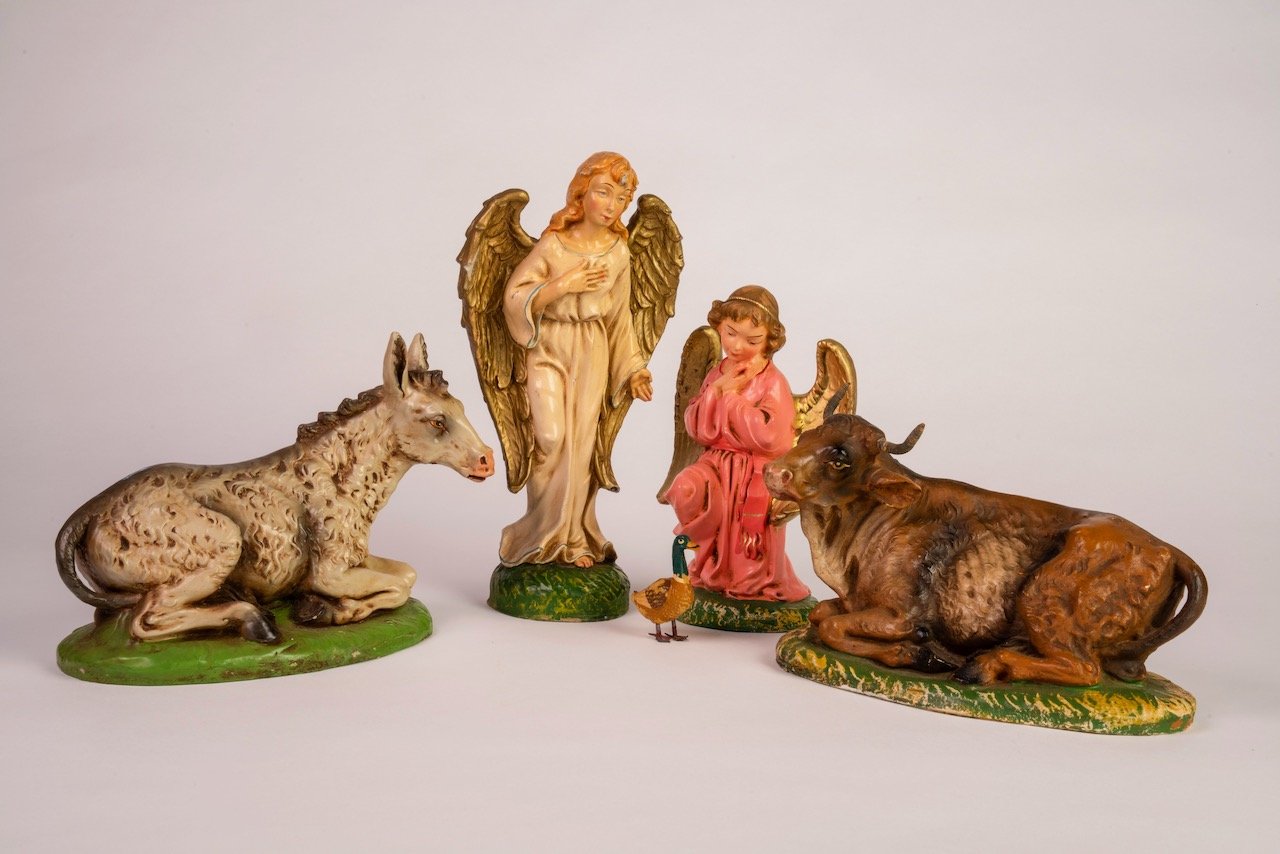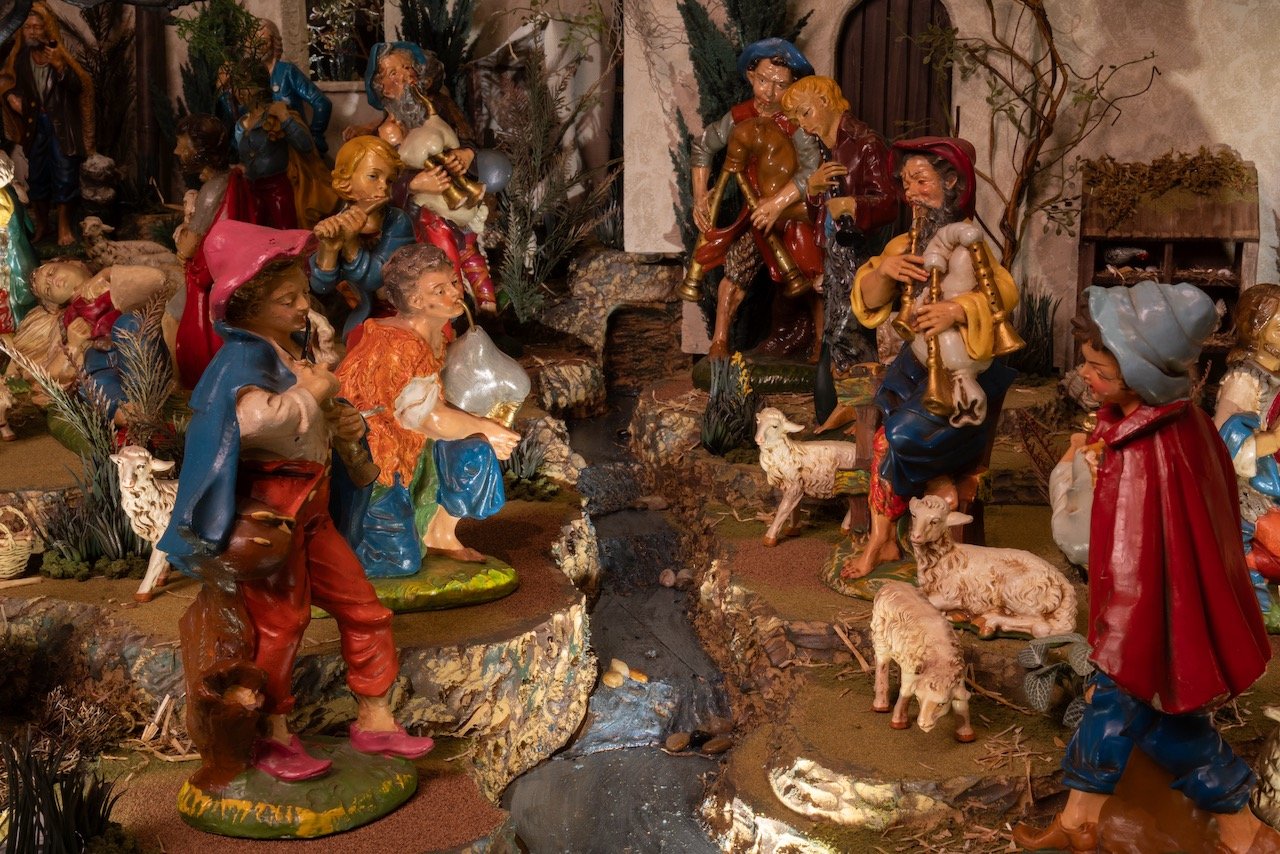Glencairn Museum News | Number 11, 2023
The Grand Cartapesta Presepe: On November 25, 2023, A.J. DiAntonio of Navidad Nativities in Bucks County, PA, delivered an illustrated presentation at Glencairn Museum about a Nativity scene he created for the Museum’s 2023 World Nativities exhibition consisting of 176 vintage Italian figures from his private collection. (Click on the video above to view the entire presentation.)
Figure 1: A.J. DiAntonio hangs his stocking while gazing up at a Nativity from India that he was fascinated with as a child.
When did you start collecting Nativities?
My collection began in 1981. I was two years old. Obviously, as a two-year-old, the collecting was slow to start. My mom had purchased a paper mache Nativity made in India from a fair-trade shop in Bryn Mawr and I was fascinated with it. Before I was allowed to play with it, I used to “steal” people’s toothbrushes and pretend they were Nativity figures. Somehow, I still have some distinct memories from back then. I remember taking my Aunt Cathy’s toothbrush when I was sleeping over at my grandparents’ house. Aunt Cathy was about 19 at the time and did not find it amusing.
The first Nativity that was actually my very own was given to me in December 1982 when my brother, Chris, was born. I refer to that Nativity as my “consolation prize.”
How many Nativities do you have currently? Is your collection still growing?
To date, there are 510 different Nativities in my collection. Although I have said on multiple occasions this year that I don’t need to keep adding, once in a while, I see one that I can’t resist. Of course, some of the individual scenes are still expanding, but I am trying hard to not add many more to the overall count.
Figure 2: DiAntonio in front of The Grand Cartapesta Presepe in the Upper Hall of Glencairn.
Where do you find the Nativities that are in your collection?
When I was young, my favorite place to find Nativities was The Christmas Shop in Paoli. As a young child, I know I made the owner nervous at first. The store was owned by Mildred Ericson, and she quickly became one of my favorite people. I refer to her as the first “enabler” to my collection. The Christmas Shop was a place I could go to find the best quality around.
As I grew older, I would get called in to work there after school when large orders came in. Mrs. Ericson retired in the mid-1990s and her daughter Janet and husband Rich took over the store. We became very close as well. Even now, I run into Mrs. Ericson every once in a while, and at the age of 98, she remains one of those strong influences in my life. Now, my collection grows thanks to services like eBay, Etsy, and Facebook Marketplace. You really have to know what you’re looking for, but I find most things through those sites.
Figure 3: DiAntonio in 2015, working on the design for The Bryn Athyn Nativity in the Bucks County atelier of Navidad Nativities. It is now in the Glencairn Museum collection.
What were the circumstances that led to your involvement with Navidad Nativities, Inc., in Bucks County, and how that involvement shaped your vision of Nativity collecting?
In 2013, after eight years of living in Los Angeles and producing television, I decided to move back to the area and change careers. I took a job at a local hardware store that hosts a huge Christmas shop every year. I wanted to become more familiar with the product lines they offered and decided that I needed to visit The Byers’ Choice Gift Shop & Christmas Museum in Chalfont, PA. At the end of their factory/museum exhibit is a beautiful room with glass display cases all around, filled with stunning Nativities from the personal collection of Joyce Byers. The centerpiece of their display is a beautiful 18th-century Neapolitan Presepio from Italy. The setting was created by Michael Stumpf of Navidad Nativities.
In the gift shop after the tour at Byers’ Choice, I asked the woman about the Nativities and told her I was a collector. She said they were hosting a “Nativity weekend” that November and that I should come. I showed her some photos of my collection. A few days later, I got a call from the woman at the gift shop saying that she had shared some of the photos of my collection with Joyce, and that they wanted to know if I would bring an assortment of them to display for the event. The sign billed me as “esteemed collector.”
Michael Stumpf, a long-time friend of Joyce and Bob Byers, was also invited to display an assortment from Navidad Nativities at the event. Mike invited me to visit him in his studio a week later and said we could build something together. Ten years and more than 50 custom designs later, we have made Nativity building a weekly event. It is a passion, and we love to challenge ourselves to see what we can build next.
Tell us about your new creation, The Grand Cartapesta Presepe, which is now on exhibit in Glencairn’s Upper Hall under the Christmas tree.
Figure 4: The Holy Family is at the center of The Grand Cartapesta Presepe.
The Grand Cartapesta Presepe was an idea brewing in my head for several years. The summer that I returned from California, I stumbled across the Holy Family to this incredible Nativity. Made by the Fontanini Company in the 1940s, it checked all the right boxes for me at the time. It was impressively large-scale, vibrantly colored, and made in Italy. It reminded me of the Nativity that our neighbors from the 1980s, the Kellers, had under their Christmas tree. And best of all, it was not terribly expensive (at that point). Over two or three months I had managed to track down the shepherds, kings, angels, and animals. There were twenty-one figures in all, and I was very happy with it.
Figure 5: This Holy Family from the 1940s, made by the Fontanini company, was the first of many pieces collected by DiAntonio.
Then I found an old catalog image online that showed a lot more pieces. At first, I had decided that I had plenty of figures and didn’t need to go tracking down the rare pieces. Then I found the camel driver, and then the old woman standing spinning yarn. Long story short, I started to meet other collectors and learned more about these figures. Fontanini, of course, was the primary maker, sculpted almost exclusively by Elio Simonetti. Then I learned of Euromarchi, who was from the same town as Fontanini and a major competitor with figures sculpted by Raffaello Simonetti and Leandro Rontanini. That is when the collection spiraled out of control.
More and more figures appeared, thanks in huge part to a few collectors that I found in Italy who were willing to ship these extremely rare and valuable pieces to the US. These two companies were from the same town and used several of the same artists to paint the pieces. I decided to combine the pieces into the bustling village that is now on display at Glencairn.
Figure 6: Two angels, the ox, and the donkey from DiAntonio’s collection.
What was the inspiration that led to the creation of The Grand Cartapesta Presepe?
It was just after the close of the World Nativities exhibition in 2021, as I was packing up the Nativity I had loaned to Glencairn that year, that I brought the idea of displaying these figures in a future year to Glencairn Director Brian Henderson. He told me that Glencairn would be undergoing a major infrastructure upgrade and that it would be a while before we’d be able to do it.
This past January, I visited the Christmas in the Castle exhibit (a recreation of the annual World Nativities exhibition at Glencairn) that traveled to the Blessed Michael McGivney Pilgrimage Center in New Haven, CT. It got me excited to start planning for the next Christmas. I met with Brian Henderson, Ed Gyllenhaal and Bret Bostock in March after I returned from a trip to the Italian carving studios in the Dolomites. I had three designs to share with them. The first was a wide diorama that you could look at just from its front side. The next design allowed you to step into the Nativity, and the scene would wrap around you. The last design, the one that I ended up making, took inspiration from the “Angel Tree” at the Metropolitan Museum of Art in NYC, where a large tree rises out of the center of a magnificent Nativity visible almost completely around on all sides.
The next seven months had my living room completely overtaken by this massive 100 square foot Nativity, with a large tree in the center. In truth, I think I spent far more time just thinking than physically carving the scene. But the work became more involved and the fun of seeing this come to life was present every day.
Figure 7: Drawings made during the process of planning The Grand Cartapesta Presepe. (Photo courtesy of A.J. DiAntonio.)
Figure 8: DiAntonio spent many hours sculpting the landscaping for the scene. (Photo courtesy of A.J. DiAntonio.)
Figure 9: A view of the partially finished levels in DiAntonio’s living room. (Photo courtesy of A.J. DiAntonio.)
Figure 10: The Grand Cartapesta Presepe on exhibit in Glencairn’s Upper Hall.
Figure 11: A detail of fishermen from the completed scene.
Figure 13: A vegetable stall stocked with goods.
Figure 12: Washer women cleaning clothes in a stream.
Figure 14: The pasta maker prepares noodles.
Figure 15: The Zampognari (shepherd musicians) play their instruments by a stream.
On a recent trip to Italy you met with Emanuele Fontanini, president of Roman Fontanini. What did you learn from that experience?
This past February, I traveled to Italy to meet with carving studios throughout the eastern Italian Alps. I was able to fit in a detour to Bagni di Lucca, the beautiful canyon town, to meet with Emanuele Fontanini to talk about this collection. I spent more than two hours with him in the factory. I showed him photos of figures in my collection, and it was great to hear him say, “where on earth did you find THIS one?” (Shhhh. I have two of that figure.) I learned a bit more from Emanuele about the competitive relationship with Euromarchi as well as how he could tell the carver of each figure just by seeing certain gestures. I am grateful to him for the time that he gave me.
(Interviewed by CEG)
Would you like to receive a notification about new issues of Glencairn Museum News in your email inbox? If so, click here. A complete archive of past issues of Glencairn Museum News is available online here.
















